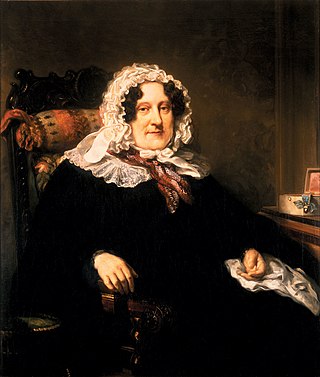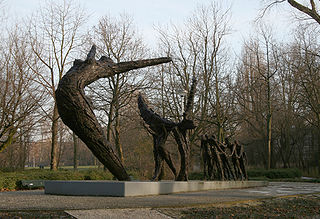
The Dutch West India Company or WICDutch pronunciation:[ʋɛstˈɪndisəkɔmpɑˈɲi] was a chartered company of Dutch merchants as well as foreign investors, formally known as GWC. Among its founders were Reynier Pauw, Willem Usselincx (1567–1647) and Jessé de Forest (1576–1624). On 3 June 1621, it was granted a charter for a trade monopoly in the Dutch West Indies by the Republic of the Seven United Netherlands and given jurisdiction over Dutch participation in the Atlantic slave trade, Brazil, the Caribbean, and North America.

The Dutch Golden Age was a period in the history of the Netherlands which roughly lasted from 1588, when the Dutch Republic was established, to 1672, when the Rampjaar occurred. During this period, Dutch trade, scientific developments, art and overseas colonisation was among the most prominent in Europe. The first half of the period spanned from the beginning of the Eighty Years' War until its conclusion in 1648, with the second half lasting until the outbreak of the Franco-Dutch War. During the period, Dutch colonialists, many of them affiliated with the East India Company and West India Company, established trading posts and colonies in the Americas, Southern Africa and Asia, protected by the powerful Dutch States Navy. The Dutch also dominated the triangular trade and Atlantic slave trade during this period.

Sinterklaas or Sint-Nicolaas is a legendary figure based on Saint Nicholas, patron saint of children. Other Dutch names for the figure include De Sint, De Goede Sint and De Goedheiligman. Many descendants and cognates of "Sinterklaas" or "Saint Nicholas" in other languages are also used in the Low Countries, nearby regions, and former Dutch colonies.

Michaël Henricus Gertrudis (Michiel) van Kempen is a Dutch writer, art historian and literary critic. He has written novels, short stories, essays, travel literature and scenarios. He was the compiler of a huge range of anthologies of Dutch-Caribbean literature and wrote an extensive history of the literature of Suriname, in two volumes.

Loango-Angola is the name for the possessions of the Dutch West India Company in contemporary Angola and the Republic of the Congo. Notably, the name refers to the colony that was captured from the Portuguese between 1641 and 1648. Due to the distance between Luanda and Elmina, the capital of the Dutch Gold Coast, a separate administration for the southern districts of Africa was established at Luanda during the period of the Dutch occupation.
Pieter (Piet) Rietveld was a Dutch economist and Professor in Transport Economics at the Vrije Universiteit, Amsterdam, and a fellow at the Tinbergen Institute. He was among the top researchers in economic geography according to IDEAS/RePEc.

Ketikoti sometimes spelled as Keti Koti, or officially Dag der Vrijheden is an annual celebration on 1 July that marks Emancipation Day in Suriname. The day is also known as Manspasi Dei or Prisiri Manspasi, meaning "Emancipation" or "Emancipation Festival". or Kettingsnijden.

Zwarte Piet, also known in English by the translated name Black Pete, is the companion of Saint Nicholas in the folklore of the Low Countries. Traditionally, Zwarte Piet serves as an assistant to the saint and distributes sweets and gifts to well-behaved children.

The International Colonial and Export Exhibition was a colonial exhibition held in Amsterdam from May 1 to October 1, 1883. The event drew at least a million visitors and was the first international colonial exhibition, with 28 different nations presenting their colonial trade and wealth.

Surinam, also unofficially known as Dutch Guiana, was a Dutch plantation colony in the Guianas, bordered by the equally Dutch colony of Berbice to the west, and the French colony of Cayenne to the east. It later bordered British Guiana from 1831 to 1966.

Netherlands–Suriname relations refers to the current and historical relations between the Netherlands and Suriname. Both nations share historic ties and a common language (Dutch) and are members of the Dutch Language Union.

Johanna Borski (1764–1846), was an influential Dutch banker. She was the director of the "Wed. Borski" bank from 1814 to 1846. In 2022 Borski was in the news with regard to whether her wealth was due to slavery.
Christ P. M. Klep is a Dutch military historian. He is a lecturer at Utrecht University and freelance historian and publicist. He has appeared amongst others on Pauw & Witteman, NPO Radio 1 and Knevel & Van de Brink, and has written for de Volkskrant, Trouw and De Groene Amsterdammer - commenting on topics as the Joint Strike Fighter program, the Russian military intervention in Ukraine and the recruiting practices of the Armed forces of the Netherlands.
Pieter Jacobus Hagen (1942) is a Dutch journalist and non-fiction author, who started his career as a reporter for the national newspaper Trouw in 1967. Later he served as teacher and dean of the School of Journalism in Utrecht (1983–1995), editor-in-chief of De Journalist/Villamedia (1995–2002), and columnist for NRC Handelsblad (2003–2005). He has been publishing non-fiction books since 1982, and has been a full-time author of history books since 2002.

Hermann Walther von der Dunk was a Dutch historian of German origin.

The Beeckestijn was an 18th-century Dutch slave ship working out of Amsterdam. She is depicted in front of the Dutch West India Company warehouses on the Prins Hendrikkade quay by the engraver Hendrik de Leth.
Eduard Siegfried"Eddy"de Jongh is a Dutch art historian specialized in iconography. He was professor of art history with a teaching assignment in iconography at Utrecht University between 1976 and 1989.

The history of Dutch slavery involves slavery in the Netherlands itself, as well as the establishment of slavery outside the Netherlands in which it played a role. The Netherlands banned the slave trade in 1814 after being compelled by Britain.
James Balfour was a Scottish-born Guyanese physician and Surinamese plantation owner. He worked as a doctor in Berbice. Later, he became a plantation owner in Nickerie District. Harriët Balfour was his daughter with a slave. He requested Harriët's freedom the day before he died.
Cornelis Reinhard Vaillant was a Dutch lawyer, judge, and colonial governor. He served as Governor of Suriname from 19 July 1816 until 1 April 1822, and as judge on the Supreme Court of the Netherlands from 1838 until 1849.














